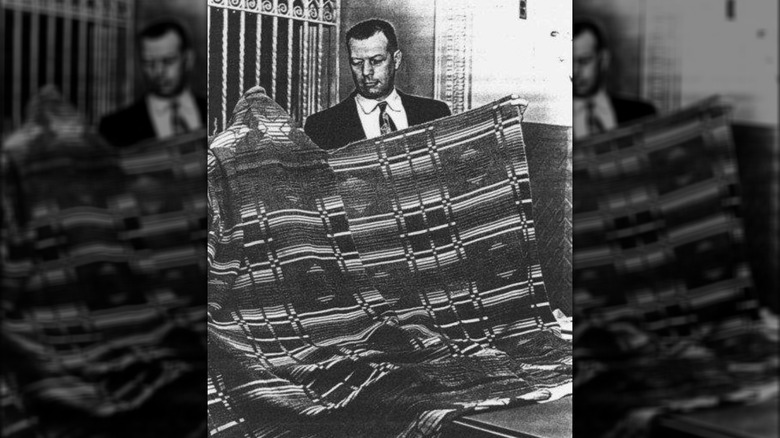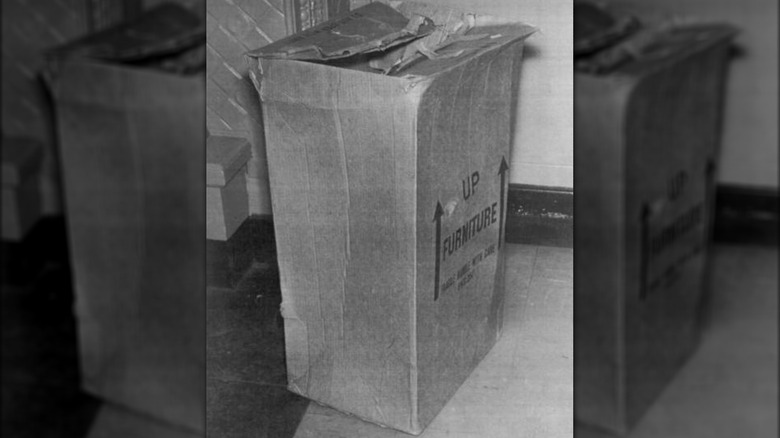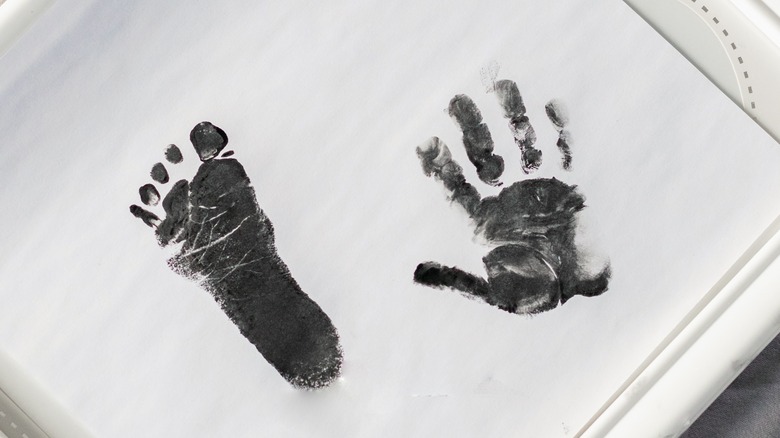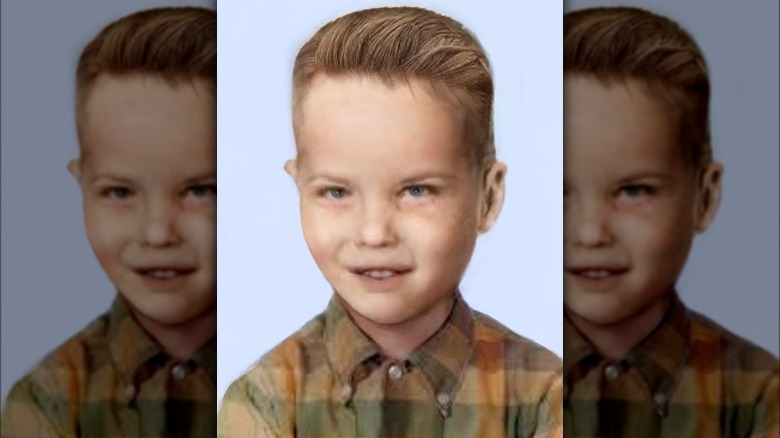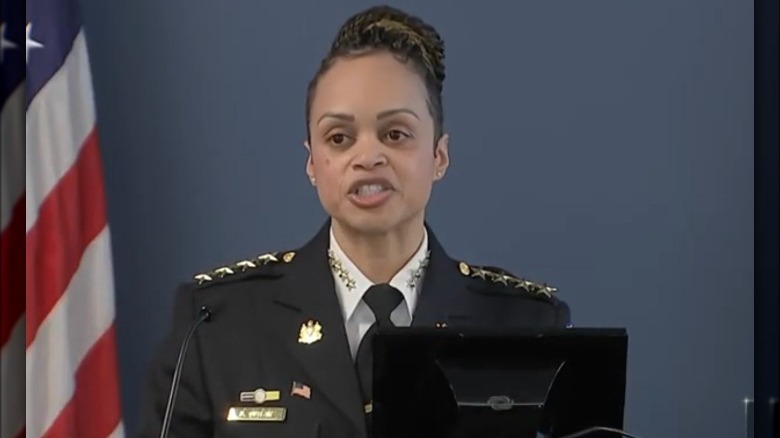The Tragic 1957 Murder Of The Boy In The Box Explained
On the morning of February 26, 1957, a La Salle University student was walking through the woods that surrounded Philadelphia, Pennsylvania's, Fox Chase neighborhood when he came across a large cardboard box that contained what appeared to be a doll. As reported by Philadelphia Magazine, the student was unnerved by the discovery and contacted local authorities immediately.
Patrolman Elmer Palmer was one of the first officers to arrive on the scene. The box was located on a dirt road, which was commonly used by local residents as a dumping ground. In addition to a variety of other trash, Palmer found the box the student called to report. Unfortunately, it did not contain a doll. Instead, the patrolman confirmed it was the body of a young boy.
A medical examiner determined the boy was 3'3 and weighed 30 pounds. As he had not lost any of his baby teeth, it was estimated that he was between the ages of four and six. However, as he was severely malnourished, they were unable to determine his specific age at the time.
Although he was nude, Philadelphia Magazine reports the boy's body was wrapped in a brown and green blanket, which had a Native American pattern. The medical examiner noted the boy was clean and his fingernails were neatly trimmed. His hair had also been recently cut, as some clippings were still present on his body. Those details may suggest the boy was well cared for, but further details revealed something far more sinister.
The Boy in the Box did not match the description of any missing children
As reported by Philadelphia Magazine, the so-called "Boy in the Box" was emaciated, to the point that his ribs were visible through the skin on his chest. He had multiple scars throughout his body, including four on his forehead. There was also a scar from a previous injury under his chin and several healed scars on his body, which suggest he had surgical procedures performed on his ankle and groin. However, he did not have any of the scars associated with certain vaccines that were common at the time.
The "Boy in the Box" did not match any descriptions of missing children in the area and no forms of identification were found with or near the body. Authorities hoped someone would eventually come forward to report the boy missing, but that never happened. In an effort to identify the child, Philadelphia Magazine reports authorities distributed an estimated 400,000 flyers. In addition to placing the flyers in public places and passing them out to pedestrians, they were also enclosed with utility bills.
According to America's Unknown Child, the flyer had three photos of the boy, which were taken by authorities, as well as a photo of the blanket that was covering his body. The Flyer also included a photo of the blue cap and a description of the bassinet that originally came in the box he was found in.
Authorities had little evidence as to the boy's identity
After distributing the flyers, authorities received hundreds of tips about the boy's possible identity. Unfortunately, none of the tips helped authorities identity the boy or who may had dumped his body in the woods.
Although there were few clues at the scene, law enforcement officials hoped they had enough information to get some kind of lead. In an attempt to find the doctor who may have performed the surgical procedures on the boy, authorities contributed to an article in a popular pediatric journal. Unfortunately, Philadelphia Magazine reports the doctor who performed the surgeries either did not see the article or simply did not come forward.
Authorities also determined the manufacturer and seller of the bassinet that was originally packaged in the box where the boy's body was found. According to Philadelphia Magazine, the bassinet was sold by the Upper Darby J.C. Penney and authorities learned only 11 of the bassinets were sold. Although they made contact with nine of the 11 people who bought the bassinets, they were unable to link any of those people to a missing child. The two other purchasers were never identified.
A blue corduroy cap, which was the size a child would wear, was also found at the scene. As reported by Philadelphia Magazine, authorities determined the cap was manufactured and sold by Philadelphia's Robbins Bald Eagle Hat & Cap company, but they had no record of who purchased their products.
An analyst sifted through thousands of birth records to no avail
According to Philadelphia Magazine, authorities spent nearly a decade doing everything in their power to find the identity of the "Boy in the Box." Fingerprint analyst Bill Kelly, who was called to the scene when the boy was found, took a special interest in the case -– and was determined to identify the boy by comparing his footprints with birth records.
Although he was not paid for the daunting task, Kelly voluntarily sifted through birth files from local hospitals and a home for unwed mothers. At the time, the only tools available to him were a magnifying glass and his own experience comparing prints. Kelly spent years trying to identify the boy using the footprints to no avail. He later went on to compare photos of the boy with more than 11,000 passport photos, as he thought the boy may have been the son of immigrants.
Remington Bristow, who was an investigator for the medical examiner's office, also took a particular interest in the case. In addition to donating $1,000 of his own money for a reward, Philadelphia Magazine reports he published an article in the local paper suggesting the boy may have died accidentally and his parents could not afford a funeral. Unfortunately, none of his efforts led to any useful information.
One theory suggests the boy was the child of an unwed mother
In 1998, law enforcement officials ordered the exhumation of the boy's body for DNA testing. As the site of his original grave was in disrepair, he was reburied in Philadelphia's Ivy Hill Cemetery when the testing was complete. It would be nearly 25 years before that DNA would help identify the "Boy in the Box."
Although authorities have never found any definitive evidence proving who killed the boy or how he died, there are several theories about what may have happened. Amid his quest for answers, Court TV reports Remington Bristow consulted a psychic, who told him the boy had lived in a foster home in Philadelphia. Using the psychic's description of the house and the family living in the home, Bristow identified the foster home he believed the psychic had described. Although the couple had already been interviewed and ruled out as suspects, Bristow conducted his own interview.
According to Court TV, Bristow became convinced that the couple's daughter may have become pregnant out of wedlock and the child was hidden and eventually killed or died by accident. Bristow suggested the body was dumped to preserve the girl's reputation.
After the family moved out of the house, Bristow attended the estate sale. He was stunned to find a white bassinet among the items for sale. However, there was never any further investigation into the family.
A woman came forward claiming her mother bought and later killed the boy
In May 2002, a woman, who has been identified only as "Martha," came forward to report the "Boy in the Box," was killed and dumped in the woods by her mother. With the assistance of her psychiatrist, "Martha" told authorities a little boy, who was named Jonathan, came to live with her and her mother when she was 11 years old.
As reported by Court TV, "Martha" said her mother picked the boy up from another home, and seemingly exchanged him for a sealed envelope. According to "Martha," the boy was kept in the basement –- where he was forced to use the floor drain for a toilet and sleep in a makeshift bed in an old coal bin. "Martha" said she and the boy were sexually abused by her mother. In her opinion, her mother purchased the boy for the express purpose of abusing him.
According to "Martha," her mother ultimately beat the boy to death after he vomited in the bathtub. She then dumped his body in the woods. Although "Martha" had a history of mental health issues, her doctor confirmed she first told the story about the boy in 1989. However, she was not ready to discuss the incident with the authorities. As of this time, authorities have not verified the details of "Martha's" story and the "Boy in the Box" case remains one of America's oldest cold cases.
The Boy in the Box was identified in December 2022
On December 8, 2022, officials with the Philadelphia police department held a news conference to announce the "Boy in the Box" was conclusively identified as Joseph Augustus Zarelli. As reported by CNN, Zarelli was four years old at his death. Philadelphia Police Commissioner Danielle Outlaw revealed Zarelli's identity was confirmed using DNA. Law enforcement officials said DNA collected from the boy was analyzed and the results were uploaded to, and compared with, an extensive DNA database. Using the database and genetic genealogical techniques, authorities could identify the boy's birth mother and father, and eventually obtain his birth certificate.
Law enforcement officials said both of Zarelli's biological parents are now deceased. However, The New York Times reports he has several surviving siblings, whose identities were not disclosed. Philadelphia Police Captain Jason Smith said It is still unclear how the boy died or who may have killed him. However, he said, "We have our suspicions as to who may be responsible, but it would be irresponsible of me to share these suspicions as this remains an active and ongoing criminal investigation."
As the case is still considered to be open, CNN reports authorities are offering $20,000 for any information leading to an arrest and conviction. Smith admitted the identification of the killer might never be known, but he has committed to doing everything possible to solve and eventually close the case.

